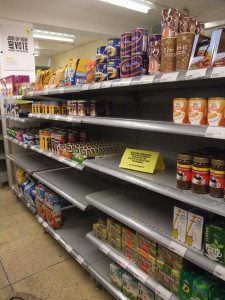
Name of Food and List of Ingredient
Name of Food: The name and trade name of the food shall be mentioned on the label.
List of the Ingredients: The list of all food articles i.e. ingredients added in the manufacture of food products are to be mentioned on the label with the title “Ingredients”. Any substance including food additives, color, preservatives added in the manufacture of food product shall be added in the list of ingredients.
The name of ingredients shall be given in descending order that means the ingredient used in higher quantity will be mentioned first than the substance used in lower quantities. Specific name of each ingredient shall be mentioned on the label.
However in some cases the class name of the food ingredient is allowed to be mentioned in place of specific name of the ingredient .For example,.if turmeric powder or chilles powder or both or any other single spice or more than one spices in combination have been used in the preparation of any food product then in place of mentioning the names of all spices used ,the class name as “spice and condiments” may be mentioned in the list of ingredients.
The ingredients falling in the respective classes, the class title as mentioned in the table may be used.
Table containing the Ingredients and Class Title
Classes
|
Class Titles
| |
Edible vegetable oils/Edible vegetable fat
Animal fat / oil other than milk fat
Starches, other than chemically modified starches
All species of fish where the fish constitutes an ingredient of another food and provided that the labelling and presentation of such food does not refer to a species of fish
|
Edible vegetable oil/ Edible vegetable fat or both hydrogenated or Partially hydrogenated oil
Give name of the source of fat. Pork fat, lard and beef fat or extracts thereof shall be declared by specific names
Starch
Fish
| |
All types of poultry meat where such meat constitutes an
|
Poultry meat
| |
ingredient of another food and provided that the labeling
| ||
and presentation of such a food does not refer to a specific
| ||
All types of cheese where cheese or mixture of cheeses
|
Cheese
| |
constitutes an ingredient of another food and provided that
| ||
the labelling and presentation of such food does not refer to
| ||
a specific type of cheese
| ||
All spices and condiments and their extracts
|
Spices and condiments or mixed spices/ condiments
| |
as appropriate
| ||
All types of gum or preparations used in the manufacture of
|
Gum Base
| |
gum base for chewing gum
| ||
Anhydrous dextrose and dextrose monohydrate
|
Dextrose or Glucose
| |
All types of Caseinates
|
Caseinates
| |
Press, expeller or refined cocoa butter
|
Cocoa butter
| |
All crystallized fruit
|
Crystallized fruit
| |
All milk and milk products derived solely from milk
|
Milk solids
| |
Cocoa bean, Coconib, Cocomass, Cocoa press cakes,
|
Cocoa solids
| |
Cocoa powder (Fine/Dust)
| ||
If the ingredient used in the product, itself is the product of one or more ingredients then such a compound ingredient shall be mentioned in the list of ingredients with a list of its ingredients in descending order within the brackets.
In some cases percentage of the ingredients added has to be mentioned. Where a food product is a mixture of two food products or the ingredient of food product, is shown as present on the label or through words or pictures then the percentage of the ingredients shown in the picture have to be mentioned.
The ingredients need not to be mentioned in a single ingredient food.
To summarize, the brand name should clearly appear on the label along with the information about all classes of ingredients and their percentage quantity used in the manufacturing of the product.